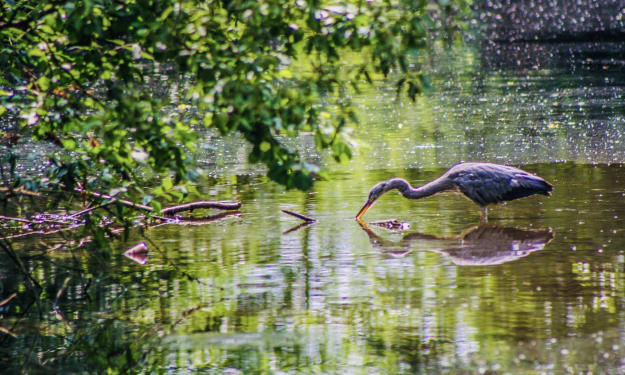
Wildlife photography is a specialized field that involves capturing images of animals in their natural habitats. It's a challenging but rewarding job that requires a lot of skill, patience, and dedication. In this article, we will take a closer look at what it's like to be a wildlife photographer and go through a typical day in their life.
Early Morning
For wildlife photographers, the early morning is the best time to capture animals in action. The photographer will need to prepare their equipment, including cameras, lenses, and tripods. Once they arrive at the location, they will set up their shot and patiently wait for the perfect moment to take the photo. This might involve waiting for hours until an animal appears.
A wildlife photographer usually starts their day before sunrise, sometimes as early as 4 a.m. They do this to capture the animals during their most active hours. They usually set up their gear and equipment the night before and ensure that everything is ready to go.
The photographer will have a clear idea of what they want to photograph and where they need to be to get the best shot. They will also consider the direction of the sun and the lighting conditions. Once they have found the perfect location, they will patiently wait for the animals to appear.
Late Morning to Early Afternoon
During this time, the photographer will explore the area to find the best location for taking photographs. They will hike through rough terrain, sometimes carrying heavy equipment to reach their desired location. Once they find the right spot, they will observe and photograph animals in their natural habitats. They will need to cope with unpredictable weather conditions, such as sudden rain, wind, or even scorching heat.

The photographer will often look for new spots to shoot as they move through the area. They are constantly on the lookout for the best angles and lighting. They will take their time and observe the animals to see how they interact with their environment. This allows them to capture the most interesting and natural shots.
The late morning to early afternoon is also a good time for the photographer to experiment with different camera settings. They can try different shutter speeds, apertures, and ISO levels to capture different moods and effects.
Late Afternoon to Evening
As the day progresses, the lighting conditions change, and the photographer will need to adjust their camera settings to get the best shots. They will capture animals in action, such as hunting, mating, or playing. However, they will also face challenges such as dust, glare, and other elements that may affect the quality of their photos. By the end of the day, they will need to wrap up the shoot and head back to their base.

The late afternoon is also a great time to photograph animals as the sun begins to set. This is known as the "golden hour," where the light is warm and soft, creating a beautiful glow. The photographer will have to work quickly during this time as the light changes rapidly.
The photographer will also face technical challenges during this time. The low light conditions can make it difficult to focus and capture sharp images. They may also have to use different lenses to capture the different perspectives that they want.
The late evening is when the photographer will pack up their gear and head back to their base. They will spend the evening sorting through the hundreds of images they've captured and choosing the best ones to edit.
Post-Production Work
After a long day of shooting, the photographer will sort through the hundreds of images they've captured. They will select the best shots and start editing them to enhance their quality. They may crop, adjust the color balance, or apply other techniques to improve the images. This post-production work can take hours or even days, depending on the number of images that need editing.
The photographer will have to be skilled in using editing software, such as Adobe Photoshop or Lightroom. They will also have to maintain a consistent editing style, so their images have a unique look and feel.
Challenges Faced by Wildlife Photographers
Wildlife photographers face a variety of challenges in their job. These challenges can be physical, technical, or ethical. For example, the physical challenges of hiking through rough terrain or carrying heavy equipment can be taxing on the body. The photographer must also be prepared to face harsh weather conditions like rain, snow, or heat.
Technical challenges like focusing in low light conditions, adjusting camera settings quickly, and dealing with fast-moving animals can also be a challenge. Wildlife photography requires a lot of patience and attention to detail. A slight mistake in focusing or exposure can ruin an entire shot.

Ethical challenges are also important to consider. Wildlife photographers must be careful not to disturb the animals they are photographing or their natural habitats. They must be aware of their surroundings and take measures to minimize their impact on the environment.
Conclusion
Being a wildlife photographer is not an easy job. It requires a lot of dedication, skill, and patience. A typical day in the life of a wildlife photographer involves waking up early, setting up equipment, exploring the location, observing and photographing animals, coping with unpredictable weather, and post-production work. Wildlife photographers also face various challenges, including physical, technical, and ethical challenges.
However, despite the challenges, being a wildlife photographer is a rewarding job. It allows the photographer to capture the beauty of nature and share it with the world. It also helps raise awareness of environmental issues and encourages people to appreciate and protect the natural world.
If you are interested in wildlife photography, remember that it takes time and practice to develop the skills necessary to excel in this field. Keep learning, exploring, and experimenting with your camera, and soon you too can capture stunning images of the animals and landscapes around you.
About the Creator
VectorWiz
Attention all businesses and individuals looking for professional vectorizing services! VectorWiz is here to offer our expertise and deliver high-quality Image Clipping Path for your brand or project.






Comments
There are no comments for this story
Be the first to respond and start the conversation.